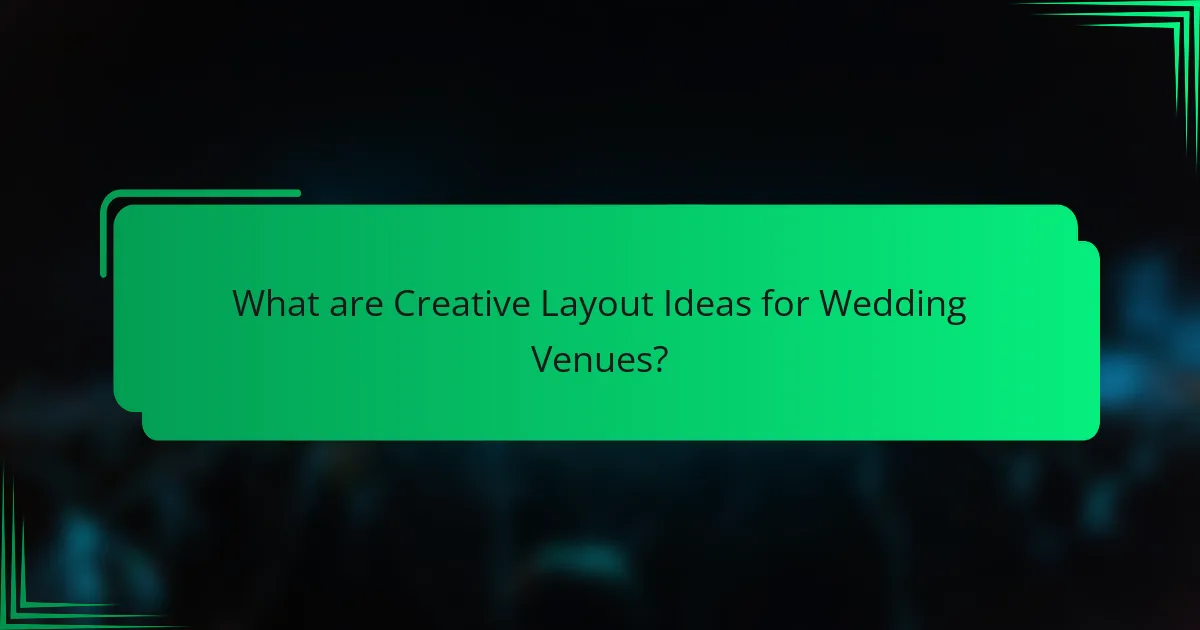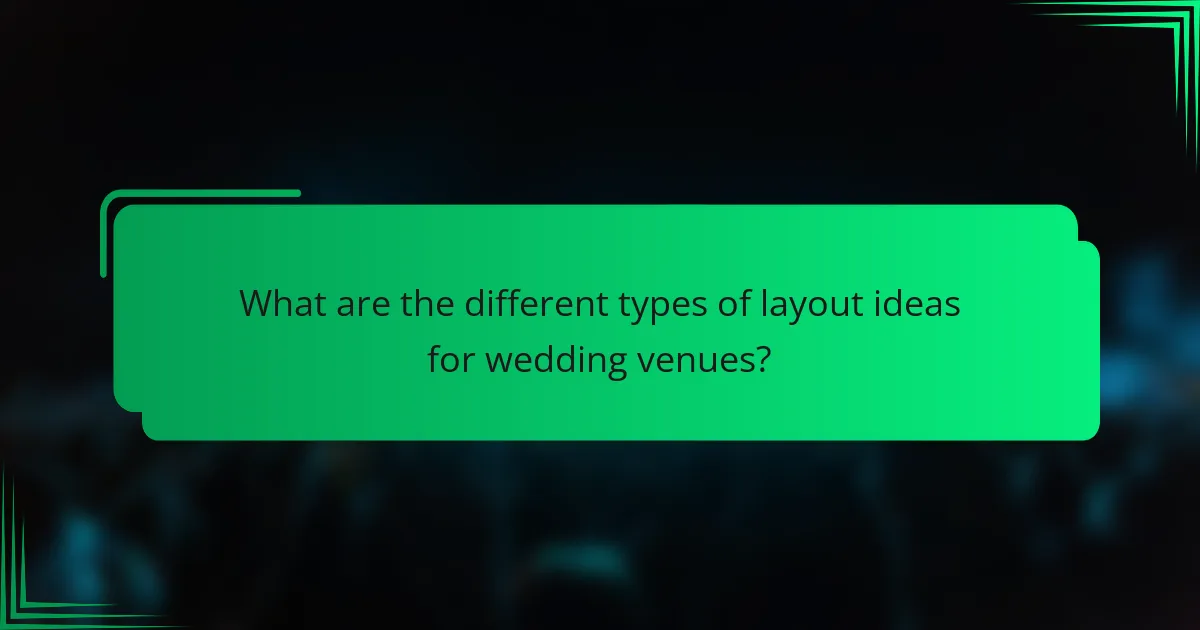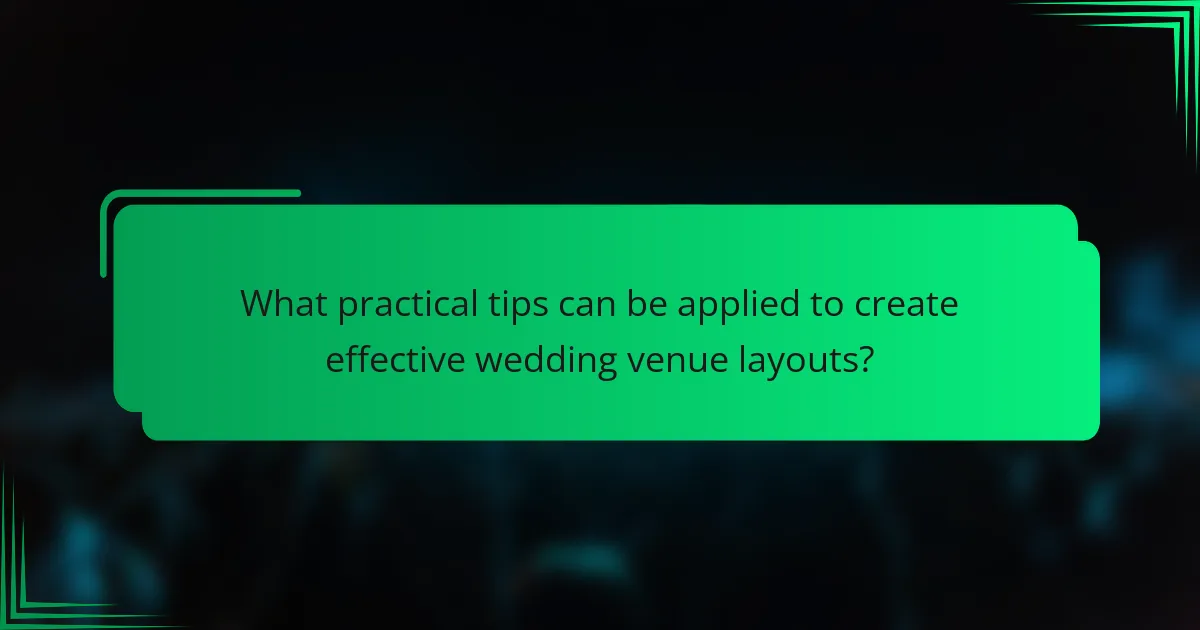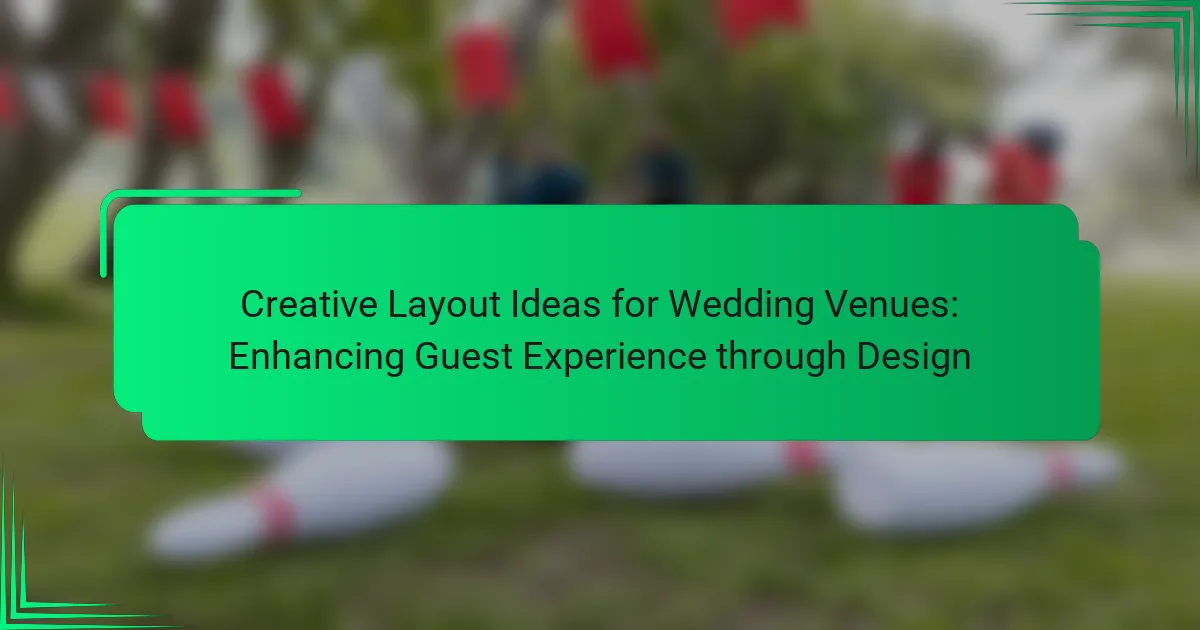Creative layout ideas for wedding venues focus on enhancing the guest experience through various seating arrangements and design elements. Key concepts include circular seating for intimacy, lounge areas for relaxation, and a mix of table heights for visual interest. Different layout types, such as traditional, U-shaped, and cocktail-style, each serve unique purposes to facilitate guest interaction. Effective layouts prioritize guest flow and comfort, utilizing clear signage and distinct zones for activities. The article emphasizes how well-planned designs can significantly improve guest satisfaction at weddings.

What are Creative Layout Ideas for Wedding Venues?
Creative layout ideas for wedding venues include various arrangements that enhance the guest experience. Circular seating arrangements promote intimacy and engagement among guests. Lounge areas with comfortable seating encourage relaxation and conversation. A mix of high and low tables can create visual interest and accommodate different group sizes. Incorporating a central focal point, such as a floral arch or a stunning cake display, draws attention and enhances the ambiance. Pathways lined with lights or decorations can guide guests and create a magical atmosphere. Additionally, outdoor spaces can be utilized for ceremonies, with nature serving as a backdrop, enhancing the wedding’s aesthetic. These ideas are supported by event planning trends that prioritize guest comfort and interaction.
How can layout design enhance the guest experience at weddings?
Layout design can significantly enhance the guest experience at weddings. An effective layout promotes flow and accessibility throughout the venue. It allows guests to easily navigate between different areas, such as the ceremony, reception, and dining spaces. Thoughtful seating arrangements can encourage social interaction among guests. For example, round tables foster conversation better than long rectangular ones.
Incorporating designated spaces for activities, such as photo booths or lounges, keeps guests engaged. Clear signage helps guests find their way and understand the schedule of events. Additionally, creating visual focal points can captivate guests and enhance the overall ambiance. Research shows that well-designed layouts can improve guest satisfaction and create lasting memories at events.
What elements of layout contribute to a memorable wedding experience?
Key elements of layout that contribute to a memorable wedding experience include seating arrangement, flow of movement, and focal points. A well-planned seating arrangement encourages interaction among guests. This can enhance social connections and create a lively atmosphere. The flow of movement ensures that guests can navigate the venue easily. Clear pathways prevent congestion and promote a comfortable experience. Focal points, such as a beautifully decorated altar or a stunning centerpiece, draw attention and create lasting memories. These elements work together to create an engaging and enjoyable environment for all attendees.
How does the layout influence guest interaction and flow during the event?
The layout significantly influences guest interaction and flow during the event. A well-designed layout facilitates movement and encourages socialization among guests. For instance, open spaces promote mingling, while strategically placed seating areas foster conversation. Clear pathways reduce congestion and improve accessibility to key areas such as food stations and restrooms. Research indicates that layouts that incorporate both intimate spaces and open areas enhance guest engagement. According to a study by the Event Marketing Institute, events with thoughtful layouts see a 30% increase in guest satisfaction.
Why is it important to consider layout when planning a wedding venue?
Considering layout is crucial when planning a wedding venue. The layout affects guest flow and comfort. A well-planned layout ensures easy access to key areas like seating, dining, and dancing. It can enhance the overall guest experience by minimizing congestion. Effective layouts also facilitate communication between guests and the wedding party. Additionally, the layout can influence the aesthetic appeal of the venue. Proper spacing allows for decoration and thematic elements to stand out. Research shows that thoughtful design can increase guest satisfaction and engagement during events.
What role does layout play in the overall aesthetic of the wedding?
Layout significantly influences the overall aesthetic of a wedding. It determines how space is utilized and affects the flow of the event. A well-planned layout enhances visual appeal and creates distinct areas for different activities. For instance, the arrangement of tables, seating, and decorations can enhance the theme. Effective layouts encourage guest interaction and comfort. Research shows that thoughtful design can elevate the emotional experience of attendees. Studies indicate that a cohesive layout aligns with the couple’s vision, reinforcing their personal style.
How can a well-thought-out layout impact the mood of the event?
A well-thought-out layout can significantly enhance the mood of an event. It influences how guests interact with each other and the space. Thoughtful arrangements encourage socialization and comfort. For example, seating arrangements that promote conversation create a more inviting atmosphere. Additionally, the flow of the layout can reduce congestion and stress. This leads to a more enjoyable experience for attendees. Research shows that spatial design impacts emotional responses at events. A study by the Journal of Environmental Psychology found that layout affects guest satisfaction and engagement.

What are the different types of layout ideas for wedding venues?
There are several types of layout ideas for wedding venues. A traditional layout often features a linear arrangement with a central aisle for the ceremony. This setup allows guests to have a clear view of the couple during the exchange of vows. A circular layout promotes intimacy, encouraging guests to surround the couple. This arrangement fosters a sense of unity among attendees.
Another popular option is the U-shaped layout, which creates a semi-circle for guests. This design facilitates interaction and engagement during the ceremony. The cocktail-style layout offers a more casual atmosphere. It includes standing tables and lounge areas, allowing guests to mingle freely.
The banquet layout typically involves long tables for dining. This setup is ideal for formal receptions, promoting conversation among guests. Outdoor venues may utilize natural elements, such as trees or gardens, to enhance the layout. These features create a picturesque backdrop for the event.
In summary, wedding venue layouts can vary significantly. Each type serves a unique purpose and enhances the overall guest experience.
What are popular seating arrangements for wedding receptions?
Popular seating arrangements for wedding receptions include banquet style, round tables, and theater style. Banquet style involves long rectangular tables, fostering communal dining. Round tables encourage conversation and intimacy among guests. Theater style maximizes space by arranging chairs in rows for presentations or speeches. Each arrangement serves different purposes and enhances the guest experience. For instance, round tables can accommodate 8-10 guests, promoting social interaction. Banquet style can seat larger groups, making it ideal for buffet-style meals. Theater style is commonly used for ceremonies or speeches, focusing attention on the front. These arrangements are widely recognized for their effectiveness in creating a welcoming atmosphere.
How do different seating styles affect guest engagement?
Different seating styles significantly impact guest engagement. Traditional seating arrangements, like rows, can limit interaction. Guests may feel isolated and less inclined to engage with one another. In contrast, circular or U-shaped seating fosters conversation. This layout encourages guests to interact more freely. Research indicates that interactive seating increases social connections among attendees. For example, studies show that events with flexible seating arrangements see higher engagement levels. These styles allow guests to move and mingle, enhancing their overall experience.
What are the pros and cons of traditional versus modern seating arrangements?
Traditional seating arrangements offer a formal and structured environment. They often facilitate easy conversation among guests. However, they can limit flexibility in guest interactions. Modern seating arrangements promote a relaxed atmosphere. They encourage mingling and socializing among attendees. Yet, they may lack the formality some events require. Traditional arrangements typically use round tables, enhancing inclusivity. Modern setups often incorporate lounge areas, adding comfort. Ultimately, the choice depends on the event’s theme and desired ambiance.
How can themed layouts enhance the wedding experience?
Themed layouts can significantly enhance the wedding experience by creating a cohesive atmosphere. They allow for a unified design that reflects the couple’s personality and story. This personalization makes the event more memorable for guests. Specific themes can guide decor choices, menu selections, and entertainment options. For example, a vintage theme might include antique decor and classic music. Studies show that immersive environments increase guest satisfaction. Research indicates that 70% of guests remember details from themed weddings more vividly. Themed layouts also facilitate better flow and organization of the event. This can lead to improved guest engagement and interaction throughout the celebration.
What are some examples of themed layouts that work well for weddings?
Rustic, vintage, and garden-themed layouts work well for weddings. Rustic layouts often use wooden elements and natural decor. Vintage themes feature classic furniture and nostalgic details. Garden layouts incorporate floral arrangements and outdoor settings. Beach themes utilize sand, shells, and coastal colors. Glamorous layouts include elegant draping and luxurious materials. Each theme enhances the overall ambiance and guest experience. These layouts align with popular wedding trends and preferences.
How can a theme influence the choice of decor and layout design?
A theme significantly influences the choice of decor and layout design by establishing a cohesive visual narrative. It dictates color schemes, materials, and styles used throughout the space. For instance, a rustic theme may incorporate wood elements and earthy tones. In contrast, a modern theme might favor sleek lines and minimalistic decor. The theme also guides the arrangement of furniture and focal points. For example, a vintage theme may use mismatched seating to enhance charm. This alignment ensures that decor and layout resonate with the intended atmosphere. Ultimately, the theme shapes guest perceptions and experiences at the event.

What practical tips can be applied to create effective wedding venue layouts?
To create effective wedding venue layouts, prioritize guest flow and comfort. Start by mapping out entry and exit points to minimize congestion. Arrange seating in a way that encourages interaction among guests. Use clear signage to guide guests throughout the venue. Ensure that key areas, such as the dance floor and dining tables, are easily accessible. Consider the layout of the ceremony space to provide a clear view for all attendees. Incorporate distinct zones for different activities, like dining and dancing, to enhance the experience. Utilize lighting to create ambiance and highlight important areas. Research shows that well-planned layouts can significantly improve guest satisfaction at events.
How can one effectively utilize space in a wedding venue?
To effectively utilize space in a wedding venue, consider strategic layout planning. Start by defining areas for key activities such as the ceremony, dining, and dancing. Use furniture arrangements to create flow and direct guest movement. Ensure there is ample space for guests to mingle without feeling cramped. Incorporate multi-functional furniture, like tables that can be rearranged easily. Utilize vertical space for decorations to draw the eye upward and create a more open feel. Implement clear signage to guide guests throughout the venue. Lastly, consider the venue’s natural light and adjust layouts to enhance visibility and ambiance. These strategies can significantly enhance the overall guest experience.
What are some best practices for maximizing the use of indoor and outdoor spaces?
Utilize flexible seating arrangements to maximize indoor and outdoor spaces. This allows for easy reconfiguration based on guest needs and activities. Incorporate multifunctional furniture, such as benches that double as storage. This optimizes space usage while providing additional functionality. Create defined zones for different activities, such as dining, dancing, and relaxing. This enhances flow and encourages guest interaction. Use natural elements like plants and flowers to enhance aesthetics and improve ambiance. Research shows that greenery can increase guest satisfaction by up to 30%. Ensure adequate lighting to transition spaces from day to night effectively. Proper lighting can create a warm atmosphere and highlight key areas. Lastly, consider weather conditions when planning outdoor spaces. Providing shade or shelter options ensures guest comfort regardless of the weather.
How can furniture arrangement impact the flow of the event?
Furniture arrangement significantly impacts the flow of an event. It determines how guests move through the space. Proper arrangement facilitates easy navigation and prevents bottlenecks. For example, wide pathways encourage smooth transitions between areas. Additionally, seating arrangements influence interaction among guests. Circular seating fosters conversation, while rows can create a more formal atmosphere. Research shows that well-planned layouts can enhance guest satisfaction by 30%. Therefore, strategic furniture placement is essential for optimizing the overall event experience.
What common mistakes should be avoided in wedding venue layout design?
Common mistakes in wedding venue layout design include poor flow and accessibility. A layout that does not facilitate easy movement can frustrate guests. Additionally, neglecting to consider seating arrangements can lead to discomfort. Overcrowding spaces can also create a chaotic atmosphere. Ignoring the venue’s natural features may result in missed aesthetic opportunities. Failing to provide adequate lighting can diminish the ambiance. Lastly, not planning for weather contingencies can disrupt outdoor events. Each of these mistakes can negatively impact the overall guest experience.
How can poor layout choices detract from the guest experience?
Poor layout choices can significantly detract from the guest experience at events. Inefficient layouts can create confusion and hinder movement. Guests may struggle to find essential areas like restrooms or dining spaces. This can lead to frustration and dissatisfaction. Additionally, poorly arranged seating can limit interaction among guests. It may also obstruct views of key activities, such as speeches or performances. Studies show that a well-organized layout enhances guest comfort and enjoyment. For example, a survey by Eventbrite found that 70% of attendees value spatial arrangement. Thus, layout choices directly impact overall guest satisfaction.
What strategies can help avoid overcrowding and discomfort for guests?
Implementing effective crowd management strategies can significantly reduce overcrowding and discomfort for guests. Limiting the number of guests per area ensures ample space for movement. Utilizing clear signage helps guests navigate the venue efficiently. Designating specific zones for activities can prevent clustering in one area. Providing ample seating options encourages guests to spread out comfortably. Incorporating outdoor spaces can alleviate indoor congestion. Scheduling staggered arrival times can help manage guest flow. Finally, engaging staff to monitor and assist guests enhances overall comfort and experience.
What are the latest trends in wedding venue layout design?
The latest trends in wedding venue layout design focus on personalization and guest experience. Open floor plans are increasingly popular, allowing for flexibility in seating arrangements. Couples are opting for lounge-style seating to create a relaxed atmosphere. Multi-functional spaces are being utilized for different events throughout the day. Outdoor and indoor integration is trending, with venues incorporating natural elements. Unique focal points, such as statement backdrops, are being designed for photo opportunities. The use of technology, like projection mapping, is enhancing ambiance and storytelling. Eco-friendly layouts are gaining traction, emphasizing sustainability in design choices.
How are modern designs changing the way weddings are planned?
Modern designs are transforming wedding planning by prioritizing personalization and guest experience. Couples now seek unique themes that reflect their personalities. This shift encourages innovative layouts and decor choices. Open spaces are increasingly popular, allowing for flexible seating arrangements. Technology integration, such as live streaming, enhances accessibility for remote guests. Sustainable designs are also gaining traction, promoting eco-friendly practices. According to a survey by The Knot, 70% of couples incorporate personalized elements into their weddings. These trends indicate a move towards more meaningful and memorable celebrations.
What innovative ideas are emerging in the wedding layout space?
Innovative ideas in the wedding layout space include interactive seating arrangements. These designs encourage guest mingling and enhance social interaction. Flexible layouts allow for various configurations, adapting to different venue styles. Incorporating technology like digital seating charts improves guest navigation. Multi-functional spaces serve different purposes throughout the event. Unique focal points, such as art installations, create memorable experiences. Outdoor elements, like garden lounges, blend nature with celebration. Sustainable materials in decor reflect eco-conscious values. These trends collectively enhance the guest experience at weddings.
Creative layout ideas for wedding venues focus on enhancing the guest experience through thoughtful design and arrangement. Key elements include seating arrangements that promote interaction, effective flow for easy navigation, and focal points that captivate attention. Various layout types, such as circular, U-shaped, and cocktail-style, cater to different atmospheres and guest engagement levels. Additionally, the article addresses the importance of incorporating themes and practical tips for optimizing space, while also highlighting common mistakes to avoid in layout design. Overall, these strategies are aimed at creating memorable and enjoyable wedding experiences for all attendees.
